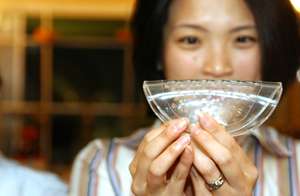Chemist develops plastic with changeable conductivity

Dr. Yueh-Lin (Lynn) Loo at The University of Texas at Austin has modified a plastic so its ability to carry an electrical current can be altered during manufacturing to meet the needs of future electronic devices.
Loo, an assistant professor of chemical engineering, studies the plastic called polyaniline because it could serve as flexible, inexpensive wiring in future products such as military camouflage that changes colors, foldable electronic displays and medical sensors.
By combining polyaniline with a chemical that gives it conductivity, Loo discovered she could increase the plastic’s conductivity one- to six-fold based on the version of the chemical added. The results involving the chemical polymer acid were published in the April 7 issue of the Journal of Materials Chemistry.
Chemically altered polyaniline has several advantages over the more commonly used metals, like gold and copper, in devices other than computers. For example, Loo’s previous research has demonstrated that “doped” polyaniline can be manufactured in solution at room temperatures and without vacuum chambers. Producing metal-based wires requires special manufacturing conditions in addition to the high cost of the metals.
Since Loo’s laboratory submitted their research to the Journal of Materials Chemistry, they have developed a version of polyaniline whose conductivity is 10 times higher than before. However, that level of electrical conductivity still doesn’t rival that of copper, which is used to produce high-speed interconnections.
That effort will be based on the greater understanding Loo has gained of the polyaniline/polymer acid described in the Journal of Materials Chemistry article. In the article, graduate student Joung Eun Yoo and other members of Loo’s laboratory began determining how higher-mass versions of polymer acid improve the plastic’s conductivity when the two materials are combined. So far, they have learned that the higher mass acids attach to the plastic in longer chains, and induce a less-ordered internal structure (crystallinity) within the plastic.
“Understanding how the structure of this polyaniline material changes when its conductivity changes will be crucial for selecting the right material for different consumer applications,” Loo said.
She noted that the ability of the plastic to change colors depending on whether it was conductive or not could be especially useful.
“Its general versatility could lead to a variety of new consumer products in upcoming years,” she said.
Loo has begun collaborating with Research Professor Adam Heller at the university to investigate using polyaniline as part of a sensor material in medical devices. Heller previously developed two commercially available devices to monitor glucose levels in people with diabetes.
Source: University of Texas at Austin


















